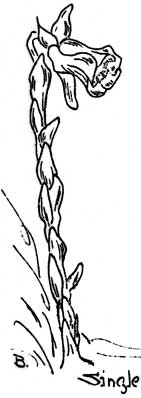|
MOUNT RAINIER NATURE NEWS NOTES
|
| Vol. VII |
August 15th, 1929 |
No. 10 |
AN INTERESTING PLANT FAMILY

Among the many species of plants that have been labeled and displayed
to aid the Park visitor at Longmire none have excited more comment than
a small group of colorless, saprophytic plants. These are all true
flowering plants and are members of the Pyrola family. They are all
inhabitants of the deep, shady woods and have adapted themselves to get
along without the sunshine so necessary to many other flowers for they
live entirely upon the decayed matter of the forest floor and having
lost all green coloring matter and, having no further use for leaves,
they are possessed only of leaf scales which serve the purpose.
The most showy of these is the Barber's Pole (Allotropa virgata).
This is a beautifully red and white striped plant with a single stem,
one to three feet tall and with a terminal raceme of flowers as add as
the stem. It has no corolla but its sepals are nearly white and united
at the base while the anthers project beyond the sepals and are a dark,
chocolate brown -- as is also the large ovary and smaller stigma. This
queer combination of colors - red, white and brown -- attracts, as you
may well imagine a great deal of attention both in the flower display
and along the trails. Pine Drops or Pine Sap (Pterospora andromeda) is
another plant much like the Barber's Pole in manner of growth but much
more common, usually occurring in small colonies. This plant has a red
sticky stem and a large terminal raceme of nodding flowers. The stems
die in the fall and may be found in this condition at all seasons of the
year.

|
The many flowered Indian Pipe (Hypopitys hypopitys) is now just
pushing its way up through the forest floor. It comes through the ground
very red in color and with its several flowers all rolled up. It is then
that the flowers have a nodding character but later, when the stem
becomes greatly elongated, these colorless flowers assume an upright
position. This, like the Pine Drop, occurs in small colonies. At a lower
level than Longmire, on Tahoma Creek near the Park Entrance, is found
the Single Flowered Indian Pipe (Monotropa uniflora), also called the
Ghost Plant because of its pearly white color. It is very numerous at
this elevation but 500 feet higher it is not found at all.
But most rare of these strange plants is the Cone Plant (Hemitomes
congestum) which is not often found by the tourist. For three years the
writer has tried to preserve a small group of these interesting plants
in the center of the Auto Camp. It grows in dense clusters and only
pushes its way a few inches above the ground. The dense cone -- like
groupe of flowers is a beautiful rose pink in color when in their prime
but with age they turn black -- as do nearly all members of this
group.
. . Charles Landes, Ranger-Naturalist.
|

|
|

